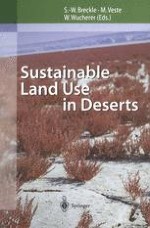2001 | OriginalPaper | Chapter
Sedimentary Environments in the Desiccated Aral Sea Floor: Vegetation Recovery and Prospects for Reclamation
Author : A. Yair
Published in: Sustainable Land Use in Deserts
Publisher: Springer Berlin Heidelberg
Included in: Professional Book Archive
Activate our intelligent search to find suitable subject content or patents.
Select sections of text to find matching patents with Artificial Intelligence. powered by
Select sections of text to find additional relevant content using AI-assisted search. powered by
Desert shrublands, all over the globe, are characterized by a patchy distribution of plants. Biomass and productivity are limited to small fertile sites. The distance between the patches, and the extent of the fertile patches, are controlled by the specific local edaphic conditions. In a non-saline environment the spatial distribution of the fertile spots is determined by spatial and temporal changes in the water regime, related to spatial differences in water input and water infiltration depth. Under a given climatic regime the differences in the water regime are basically controlled by surface properties. A compacted topsoil surface would limit infiltration depth and enhance runoff generation. Runoff generated at compacted areas is absorbed, on its way downslope, by riparian areas with high infiltration rates, where infiltration at a depth beyond that allowed by the direct rainfall occurs, creating local fertile spots. Patchiness increases tremendously in areas where, as is the case of the Aral region, differences in salinity and subsurface water drainage accompany the spatial non-uniform water regime.
